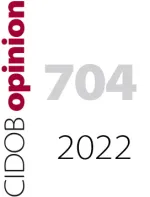Border Necropolitics

* This article was previously published in the daily ARA
It is calculated that in 2021 alone 4,404 people drowned when they were trying to reach Spanish coasts. By contrast with 2013, nobody seems to feel guilty now. Three stories (about rescue, traffickers, and governments of neighbouring countries) explain this growing indifference and acceptance of the idea that these deaths, frequently deaths by omission, are the inevitable collateral effects of Europe’s non-arrival policies.
“This is not the Europe we want to live in”, said European Home Affairs Commissioner, Cecilia Malmström when 366 people died off the island of Lampedusa. This was October 2013. Just over eight years later, the official Mediterranean death toll has risen to more than 23,000. In fact, there are many more. Most of the dead disappeared before they could be counted, as also happened in the Mediterranean’s extension (in migratory terms), namely the Sahara Desert. According to the annual report of the NGO Caminando Fronteras (Front Line Defenders), in 2021 alone 4,404 people drowned when they were trying to reach Spanish coasts. Added to toll for 2021 are the other refugees who froze to death on the Polish border, and those who drowned in the English Channel in ever more desperate attempts to reach the United Kingdom.
By contrast with 2013 nobody seems to feel guilty now. This indifference can be explained by a triple twist in the stories about the deaths at borders. The first dates from the end of 2014, when maritime rescue ceased to be a priority. Talk about the need to save lives continued but now the argument was that the best way to do it was ending rescue operations, which were presented as encouraging people to risk their lives. The logic was, the more control and the more returns, the fewer departures and, therefore, the fewer deaths. After all, who would dare to risk their lives knowing that they would not be rescued, or that they would be sent back immediately? “Drown an immigrant to save an immigrant” was how The Telegraph summed it up.
The second twist came with the refugee reception crisis of 2015. At that point, the policies of “saving lives” turned into operations of “combatting and struggling against traffickers”. The reasoning was that destroying the boats that transported migrants would not only save their lives, but it would also ensure that they would not fall victim to slavery. Rescue, then, took a “preventive” turn by keeping migrants on dry land. At the discursive level, traffickers were to blame. The more vicious and brutal their portrayal, the more humane and freer of responsibility European border policy seemed to be.
After 2020, the weaponising of refugees by neighbouring countries (Turkey in February 2020, Morocco in May 2021, and Belarus in the autumn of 2021) has given the third twist to the tale. With every crisis, the EU has been scandalised by the “cynicism” and “indecency” of the governments of these countries while, at the same time, has not hesitated to declare “war” in both tone and deed (for example, with the deployment of national armies along borders). In this new situation, no one is talking about saving lives. The matter is now presented in terms of not falling into the “trap”. And the trap is migrants who, it is said, must be stopped and sent back as soon as possible. So, the present position is that anything goes when it comes to protecting EU “borders and territorial integrity”.
Three stories in little more than eight years: stop rescues so they will stop leaving; fight traffickers to keep them on dry land; and send them back no matter how, and as soon as possible as an emphatic response to threats by neighbouring countries. These are no mere justifications. The power of the story is profoundly performative. Interpretations (more than facts) are what determine our responses. Thus it is that, from these stories, policies emerge, from drastic curtailment of the rescue capacity of northern coastguards and outsourcing of rescue to southern coastguards (any which way), to criminalisation of NGOs working in border areas and, with refugees being weaponised, the normalisation of “push backs” and suspension of the right of asylum.
We have unwittingly become the Europe we did not want, not only because we have normalised the deaths of thousands of people (including hundreds of children) at our borders every year but also because we have accepted that these deaths, often deaths by omission, are the other face of the border, collateral effects of our own non-arrival policies. In this sense, they are not just accidental deaths, but they are part of border necropolitics, which sacrifices the lives of some people (non-citizens, outsiders, those who are not seen as belonging to “us”) to the right of states to “defend” their borders.
Keywords: migration, border, migrants, outsourcing, Mediterranean, rescue, human trafficking, EU, necropolitics, Europe
* This article has received funding from the European Commission’s 2020 Horizon Europe research and innovation programme, under grant agreement number 101004564 (BRIDGES project). The contents of the article are the sole responsibility of the author/s and do not necessarily reflect the views of the European Union. The European Commission and the European Research Executive Agency are not responsible for any use that may be made of the in formation contained in this article.
E-ISSN: 2014-0843